Karen Pittman and Gary Briggs on the Elephant in the Classroom
Key Points
-
When asked “where did learning happen for you?” everyone roots that experience and place in a relationship.
-
It’s important to remind teachers that half the people in the building are not teachers.
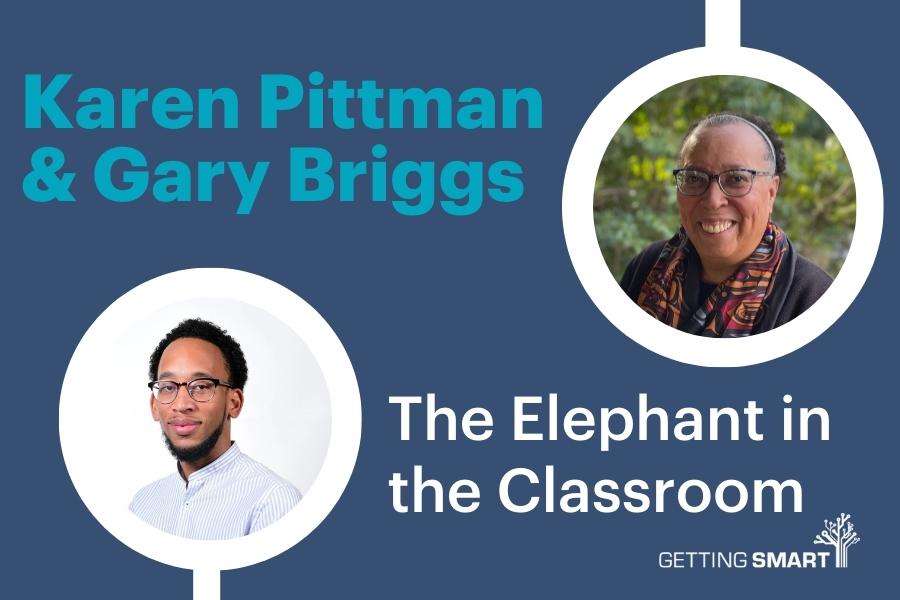
On this episode of the Getting Smart Podcast Tom Vander Ark is joined by Karen Pittman, Partner at Knowledge to Power Catalysts and Gary Briggs, Director of Systems Impact at New Teacher Center to discuss a recent report, The Elephant in the Classroom. This position paper articulates a new, shared purpose for education and paints a picture of what it would look like if our systems were rooted in a vision that centered equity, humanity, justice, and self-actualization for students and adults.
American education systems and structures are designed to produce inequitable outcomes. It’s the elephant in the (class) room — the problem we don’t want to discuss because the truth is uncomfortable and challenging to change.
Elephant in the Classroom
Transcript
Tom Vander Ark: Gary, what is the elephant in the classroom?
Gary Briggs: Ah, so, Tom, the elephant in the classroom is NTC’s point of view, and we think that it’s something that most of us can agree on—until we think about the ideas and strategies in the elephant in the classroom. These are things that are well-supported by the science of learning and development. Some of the things that we are really honing in on with this point of view that we have adopted is that we want to make sure that we are all working in service of students. We want to ensure that all students have a healthy ecosystem so they can truly self-actualize their innate talents and gifts. So we really want to make sure students can become their fullest selves, in the greatest sense. Within that, we’re aiming to create really inclusive environments, safe spaces for students to be actively engaged in rigorous learning. We also want educators, who are critical parts of this ecosystem, to have the tools they need to thrive and to connect with other educators, as well as community members, to support their efforts in the classroom. We envision schools as thriving centers for our communities, and we’re expanding our ideas about who can engage in the school setting, pushing ourselves to think expansively about who can positively affect the lives of young people. This requires us to do co-designing within the system, bringing all stakeholders together to ensure alignment and collaboration because, often, people are working in silos. The Elephant really pushes us to think creatively about breaking down those silos and establishing processes that bring all stakeholders together to support the students. So when students look around, they see a team of caring, loving adults from different walks of life working to advance their goals and helping them become their best selves.
Tom Vander Ark: You’re listening to the Getting Smart podcast. I’m Tom Vander Ark, and I’m joined today by Gary Briggs from the New Teacher Center. Gary’s got a new report out called The Elephant in the Classroom. Gary, welcome to the podcast.
Gary Briggs: Thank you for having me, Tom.
Tom Vander Ark: And the one and only Karen Pittman. Karen, it’s so good to have you back. I’ve missed you. It’s good to see you. Karen Pittman is the most important advocate for out-of-school time in America, and she has been for more than 30 years.
Karen Pittman: It’s great to be here. It’s wonderful to be with you, Tom.
Tom Vander Ark: I was being generous, Karen. It has been fifty years. I knew that. You’ve just helped me—and I think the rest of America—understand learning in a deeper and better way, and understand how important learning ecosystems are. So I’m deeply grateful to have you back on the podcast. How did you get connected with the New Teacher Center? Is this a newer or old relationship?
Karen Pittman: This is an expanded relationship. I got to know Ellen Moir, the former CEO of the New Teacher Center, when she was on the National Commission for Social, Emotional, and Academic Development, also known as the SEAD Commission. We bonded there. Then, about three years ago, under new leadership, NTC set up an equity commission, and I was invited to be a commissioner. I was intrigued by what they were doing and by the inclusion of my favorite topic—how we can help people understand the power of learning with more people, more places, and more possibilities, especially beyond the school building. So, I stayed on as a consultant, an advisor, and now a champion.
Tom Vander Ark: I appreciate that. Gary, I noticed that my friend Tommy Chang recently joined the New Teacher Center as the new CEO. Did he join around the same time you did?
Gary Briggs: Yes, we joined around the same time. He came on maybe a month or so before me.
Tom Vander Ark: I met Tommy when he was a principal in Venice, California, twenty-five years ago. He’s a great champion for learners and for equity. I’m excited that both of you have joined the New Teacher Center. What was attractive to you about NTC, Gary?
Gary Briggs: Before working at NTC, I was with an organization that helped families navigate the educational system, particularly in New Orleans, where I’m from. When I saw that NTC was making a pivot towards co-designing systems and really bringing all stakeholders to the table, it was intriguing. In my previous role, I was a teacher and had worked closely with families, so I had both perspectives. This work of bringing all these pieces together in a cohesive way was challenging but exciting, and the co-designing element was particularly attractive. It allowed me to be a part of creating something meaningful.
Tom Vander Ark: Karen, co-designing with learners, families, and communities has been a topic you’ve championed. Did you serve as part of an equity commission that NTC put together?
Karen Pittman: Yes, there was a commission that brought together about 18 people from diverse backgrounds to really dig into the question of equity. We explored why schools are producing inequitable outcomes, drawing from both personal and professional experiences. We helped shape what became the report. I stayed on for multiple drafts, from about draft three through draft fifteen, so to speak. The commissioners are still actively involved.
Tom Vander Ark: Did the commission really embrace this idea of the elephant in the classroom—that we have a system designed to produce inequity?
Karen Pittman: Yes, the concept was central in the early drafting stages. The actual decision to call it “the elephant in the classroom” came later, as we refined our ideas. We focused on embracing teaching and learning as a dynamic human exchange, expanding the concept of educators beyond the traditional boundaries, and on co-designing with communities.
Gary Briggs: Absolutely. The elephant in the classroom really is about surfacing those things that we all know are issues in education but often don’t address head-on. We’re talking about systemic inequities that persist despite our best intentions. We know that schools often mirror the broader inequities in society, and it’s essential to bring that to light so we can work together to address it.
Tom Vander Ark: Karen, when we talk about co-design, what does that look like in practice? Are we talking about regular feedback from families and communities, or is it a deeper, more structural involvement in shaping the learning process?
Karen Pittman: It’s definitely deeper. Co-design is about creating true partnerships with families, students, and community members where they’re not just giving feedback but actually helping to shape the educational experience. This means engaging them early in the design process, listening to their lived experiences, and making sure their voices are reflected in every part of the system. For example, we might have parents and community members on advisory boards, participating in curriculum design, or helping define what success looks like for their children. It’s a shift from viewing families as passive participants to seeing them as active co-creators in the education process.
Gary Briggs: And this means really embracing the idea that everyone brings value to the table. Traditionally, schools have been structured in a way that sometimes limits engagement with families and communities. But co-design challenges us to open up those boundaries and bring people in as equals. It’s about recognizing that families and communities have knowledge and perspectives that are just as valuable as those of educators and administrators.
Tom Vander Ark: I love that. Schools have often struggled to create genuine partnerships with families, and it sounds like this approach moves beyond the typical outreach or parent-teacher conferences. Gary, how does the New Teacher Center support educators in embracing this kind of approach?
Gary Briggs: One of the things we’re doing is providing training and resources to help educators build the skills they need to engage in co-design effectively. This isn’t something that most teachers learned in their initial teacher preparation, so it’s important to give them the tools they need to build these partnerships. We also work with school leaders to create a culture where co-design is valued and supported. When teachers feel they have the backing of their leaders, they’re more likely to engage deeply with families and communities. It’s a process that takes time, but we’re committed to making it happen.
Tom Vander Ark: Karen, you’ve always been a big advocate for looking beyond the school building for learning opportunities. How does that idea fit into the work you’re doing with the New Teacher Center?
Karen Pittman: It’s central. Part of what we’re advocating for is a broader definition of what it means to educate young people. Learning doesn’t just happen inside the walls of a school; it happens in community centers, in homes, in after-school programs, and out in the world. We need to create systems that recognize and value all of these learning experiences, not just what happens in the classroom. When we talk about learning ecosystems, we’re really talking about bringing all of these different elements together in a way that supports young people holistically. This means recognizing the value of out-of-school learning experiences and finding ways to integrate them into the overall educational process.
Gary Briggs: That’s exactly right. Schools are important, but they’re not the only place where learning happens. By building partnerships with community organizations, local businesses, and other groups, we can create a more comprehensive learning experience for students. This approach also helps address some of the systemic inequities we talked about earlier. When we create strong learning ecosystems, we’re giving all students access to a wider range of opportunities and resources.
Tom Vander Ark: This all sounds so powerful and necessary. Gary, do you have any examples of schools or districts that are successfully implementing this kind of ecosystem approach?
Gary Briggs: Absolutely. One example is a district we’re working with in California. They’ve really embraced the idea of community partnerships and have built strong relationships with local organizations that provide after-school programs, mental health services, and even job training for older students. By working together, they’ve been able to create a network of support for students that extends beyond the school day and addresses their social, emotional, and academic needs. Another example is a rural district that has partnered with local businesses to provide students with real-world learning experiences. In both cases, the district has made a commitment to breaking down silos and creating a more integrated approach to education.
Karen Pittman: Those are great examples. I think what’s exciting is seeing more districts recognize the power of these kinds of partnerships. It’s not always easy, especially in rural or under-resourced areas, but when communities come together, they can create incredible opportunities for young people. It’s about using the resources you have and finding creative ways to support students in a holistic way.
Tom Vander Ark: It’s so inspiring to hear about this work. Karen, Gary, what advice would you give to educators or school leaders who want to start building this kind of ecosystem but might not know where to begin?
Karen Pittman: Start by listening. Engage with families, students, and community members to understand their needs, aspirations, and concerns. Don’t assume you have all the answers—be willing to learn from the people you’re serving. Also, don’t be afraid to reach out to community organizations, local businesses, and others who might be able to provide support. Building an ecosystem takes time, and it requires a mindset shift, but it starts with listening and being open to collaboration.
Gary Briggs: I completely agree. I would also say, don’t be afraid to start small. You don’t have to build an entire ecosystem overnight. Start with one partnership or one initiative, and build from there. As you see the impact of that work, it will inspire you and others to keep going. And remember, this work is about creating a culture of collaboration and trust. When families, educators, and community members trust each other and work together, amazing things can happen.
Tom Vander Ark: I love that advice. It’s a reminder that change doesn’t have to happen all at once; it can start with small steps that build over time. Gary, Karen, thank you so much for sharing your insights with us today. This has been such a rich conversation, and I know our listeners will be inspired by the work you’re doing. Before we wrap up, is there anything else you’d like to add?
Gary Briggs: Just that I’m grateful for the opportunity to be part of this conversation. I think it’s so important that we continue talking about these issues and finding ways to work together to support our students. Education is a community effort, and when we all come together, we can make a real difference.
Karen Pittman: I couldn’t agree more. I’m so glad to have been part of this conversation, and I hope it inspires others to think more broadly about what it means to educate young people. We have an opportunity to create something truly transformative, and I’m excited to see where this work takes us.
Tom Vander Ark: Thank you both for your time and for the incredible work you’re doing. This has been an inspiring conversation, and I’m grateful for the opportunity to share it with our audience. Thanks to our listeners for tuning in, and we’ll see you next time on the Getting Smart podcast.
Links:


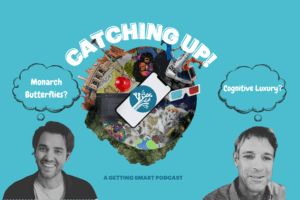
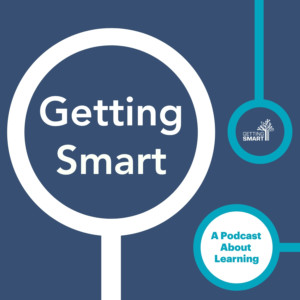

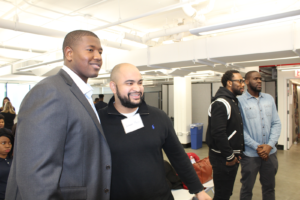
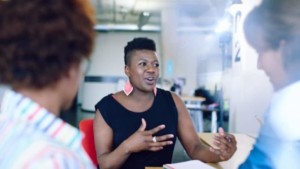
Josline
Awesome!